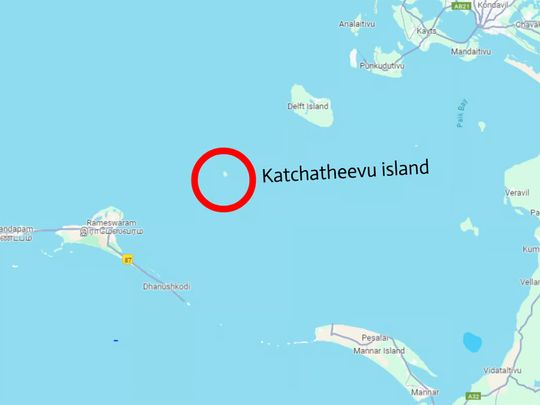
March 31, right after a rather sumptuous lunch on the long Easter weekend, I found some urgent calls nudging me out of my Sunday siesta. Given the late lunch and the welcome post-prandial slumber, it had taken me some extra hours to return the calls.
When I did so, I repeatedly heard the rather unfamiliar word Katchatheevu being flung about. Not yet fully awake, I was rubbing my eyes and wondering where and how I had heard the word. But even as I was scratching my head and prodding my sluggish brain to trawl through its old files, the speaker at the other end of the line yanked, so to speak, my chain.
They were going on air in a few minutes so it was too late to schedule me but they would have loved to hear my comments on the burning issue.
Before I could fumble a reply about my abysmal ignorance on the trending topic and politely decline the invitation, the guest relations manager of the media house blurted out, “The prime minister himself has raised this issue, citing an RTI report.
He attacked the Congress party for ‘callously giving away Katchatheevu,’ which angered all Indians and raised suspicions in their minds about how they could ever trust the Congress again.
That’s when the penny dropped. Katchatheevu was that tiny speck in the Coromandel seas, barely 12 nautical miles from Rameshwaram, the famous pilgrim town in Tamil Nadu.
Just 285 acres in area, 1.6 kilometres long and only 300 metres at its widest point, why was this barren volcanic island suddenly in the news again? Luckily for me, I didn’t have to respond immediately. The programme had already aired without me.
But now I was not only fully awake, but curious. I remembered how in 1974 Mrs. Indira Gandhi had given it to Sri Lanka. Subsequently, in 1976, the Sri Lankan government offered the far more strategically and economically significant Wadge Bank, south of Kanyakumari.
This is a 4000 sq mile area, with rich fishing grounds. Fifty years back, it was also believed that it might contain vital mineral and petroleum resources deep beneath the sea. Given this exchange between two friendly neighbours, backed by formal agreements, but without an actual exchange of territory, why was the issue suddenly trending again?
To understand this, we need to keep two things in mind. First, the tiny island of Katchatheevu was under the control of the Ramnad Raja’s zamindari in the Madras Presidency when the British ruled India. Later, after 1921, it became a disputed territory because Sri Lanka (then Ceylon), staked a claim on it.
A political slugfest
The dispute remained unsettled even after India’s independence in 1947. The island itself remained famous for a solitary church dedicated to St Anthony, which is still frequented by fisherfolk from both India and Sri Lanka. The 1974 agreement respects this tradition even while ceding control of the island to Sri Lanka.
The 1974 agreement also permitted Indian fishermen to dry their nets on the uninhabited island: “Indian fishermen and pilgrims will enjoy access to visit Katchatheevu as hitherto, and will not be required by Sri Lanka to obtain travel documents or visas for these purposes.”
But there was nothing about fishing rights in the agreement. That was the other reason why the island continued to be in the news. Because, off and on, Indian fishermen were arrested and their fishing boats confiscated for straying into Sri Lankan waters. They were usually released, but their catch spoiled, or their boats were damaged.
This caused periodic bouts of resentment among the sizeable fishing community in Tamil Nadu and Kerala’s coastal regions adjacent to Sri Lanka.
Now to the immediate context. It was the rising Tamil star and president of the Tamil Nadu state Bharatiya Janata Party (BJP), K. Annamalai, who filed the Right to Information (RTI) query on Katchatheevu.
Why? Because the BJP is looking for an emotive issue to mobilise the masses just before the general elections. Now that PM Modi has also jumped in, naturally, Katchatheevu has hit the national headlines. As usual, in a political slugfest, charges and counter charges are traded freely.
A jigsaw puzzle
The Congress counter-offensive, led by former Union Minister P Chidambaram, pointed out that the present External Affairs Minister, S. Jaishankar, then a top diplomat, was very much a part of the negotiations that resulted in the handing over of the island. What of the Tamil Nadu ruling party, Dravida Munnetra Kzhagham (DMK)? Where do they fit into the Katchatheevu jigsaw puzzle?
Well, Mrs Indira Gandhi, India’s then prime minister, had dismissed the DMK government in 1976 during the Emergency. The DMK claimed that they were against the handing over of the island to Sri Lanka.
They had even tried to move a resolution against the agreement in the Tamil Nadu assembly. But Annamalai’s RTI revealed that their supremo, M. Karunanidhi, was very much privy, possibly party, to the agreement.
Now to the current diplomatic repercussions. It is very possible that India’s Ministry of External Affairs (MEA) has alerted its counterpart in Sri Lanka not to react to this controversy, which was purely internal to Tamil Nadu’s election time politics. On the other hand, India might even be working on a deal with Sri Lanka to get the island back.
For now, it is status quo ante, as suggested by the statement by Sri Lankan cabinet minister, Jeevan Thondaman. He was quoted as saying, “Narendra Modi’s foreign policy with Sri Lanka is organic and healthy. So far, there has not been an official communication from India to return the powers of Katchatheevu island. No such request from India so far. If there is such a communication, the foreign ministry will reply to that.”
Regardless of what happens to Katchatheevu, one thing is clear. The BJP is very keen to make inroads into Tamil Nadu. They believe that they have a very good chance to bag as many as 10 seats, perhaps more. Will Katchatheevu help them attain their goal? That remains to be seen, but another salvo against the DMK bastion has certainly been fired.









